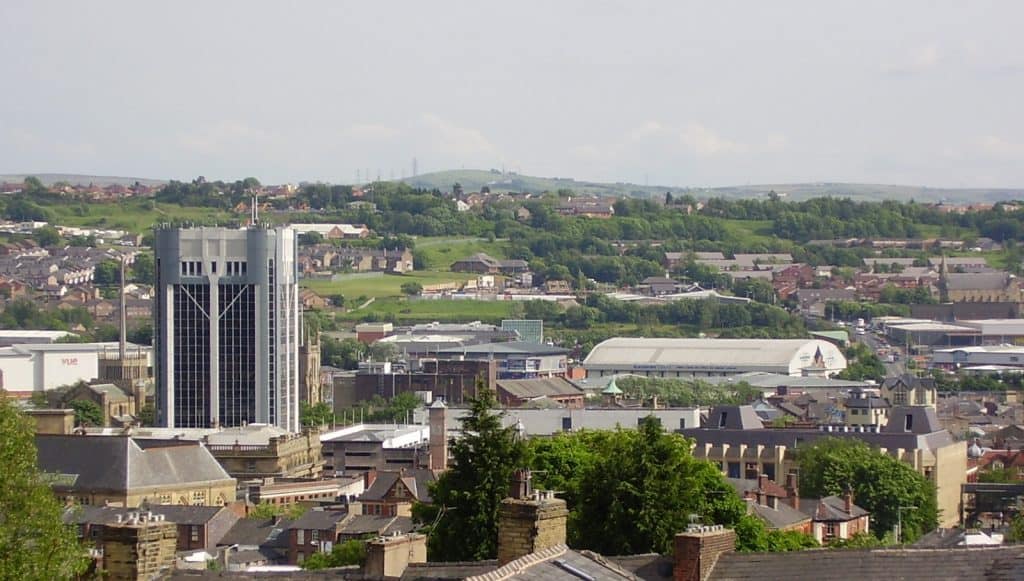Comment By Andrew Brown
The Lancashire borough of Blackburn with Darwen has now overtaken Leicester as the local authority with the highest number of Covid-19 cases. Latest figures from Public Health England show the rate of infection there was 79.2 cases per 100,000 in the seven days to July 17, almost double the previous week’s figure.
Even before today’s statistics were published, Blackburn was high on the list of areas at risk and tight restrictions were introduced on 14 July, restricting contact between members of different households and insisting on facemasks being worn in enclosed public areas.
Also causing concern is a funeral on 13 July at the Jamia Ghosia mosque in the town, which drew a congregation of 250 despite government guidelines which say that no more than 30 people should attend. The Imam has since tested positive for Covid-19, the mosque has been closed down for deep cleaning and the congregation told to self-isolate.
British Muslims are the population group most likely to catch Covid-19 and most likely to die of it. This is clear both from the ONS figures for Covid-19 fatalities when they are broken out by faith, and from the distribution of cases today, showing the rate of infection in all of the top ten local authorities have large South Asian populations and most are in the North of England.
The only religious group with comparable mortality figures were the ultra-orthodox Jews at the beginning of the epidemic.
Obviously the differential mortalities have nothing to do with theology or ethnicity.
The differentials are a reflection of social practices, and perhaps of social position in the British racialised class society.
But what are the particular practices that cause this differential and what can be done about it? Few people are willing to talk on the record about such a sensitive subject. But in Blackburn, there has been a clear pattern of transmission based on living conditions rather than religious practices.
One well-placed observer says that “this is an Asian underclass issue, to put it baldly. People from the [white, working class] estates are also getting massively hit, but this is primarily about multiple generation, multi-occupancy housing. In Blackburn the [earlier] clusters have not come from workplaces. The typical spikes came when one person in a family gets it and then others do.”
As well as the housing conditions of low-income South Asian families, other cultural factors play a role. One is the prevalence of obesity and diabetes in those communities, both known risk factors for Covid mortality. Another is the high number of workers in the health care system, something that also raises their risk.
In Leicester the spread of the disease was blamed on the cramped conditions of sweatshops – and the dreadful wages paid there meant that few people who worked in them in the first place would have had the financial reserves to stop working while the pandemic raged.
The response that has made a difference has come from within the communities themselves as much as it has come from the outside.
The government’s guidelines on the reopening of places of worship had some limitations that were clearly aimed at mosques and synagogues, such as the prescriptions about shoes and ritual washing facilities. But local councils of mosques have gone much further.
The Lancashire Council of Mosques has published very detailed plans for the reopening of religious schools, limiting the number of pupils, imposing social distancing regulations, and demanding that the ritual washing be performed at home.
In Bradford, the Council of Mosques has worked through targeted campaigns in social media, using religious leaders who are trusted by the community. Similar efforts have been made by Catholic clergy to reach the large Eastern European population of the city. “There have been very carefully balanced and crafted messages from the Council for Mosques. When your messaging goes out that way, it does work.” says one observer.
In both Bradford and Blackburn leading Muslim clerics caught the virus early, something that helped to spread the message within the communities that this was a serious danger. In Blackburn, two elderly imams died in the early stages of the lockdown; in Bradford the chairman of the Council of Mosques was ill for more than three months.
In all these cases it is not the central government’s responses which have made a difference. The messaging that gets through to vulnerable communities is generated within the communities themselves. Outside authorities can help, but only when they are themselves trusted, and this trust, on a local level, has to be earned on a personal basis.
Despite the example of Leicester, where a lockdown had to be put back into force after a resurgence of the virus, these stories are encouraging. They suggest that the poorer South Asian communities of Britain can and will avoid the kind of devastation from the virus which seemed once to threaten them.
It is one thing to recognise what the statistics show: that there are gross health inequalities in this country which are tied in some cases to faith and ethnicity, but another to yield despair about it.

















